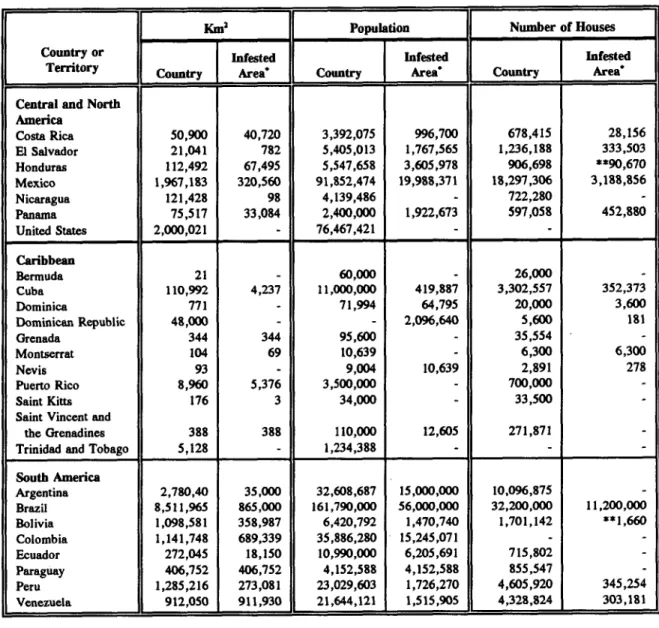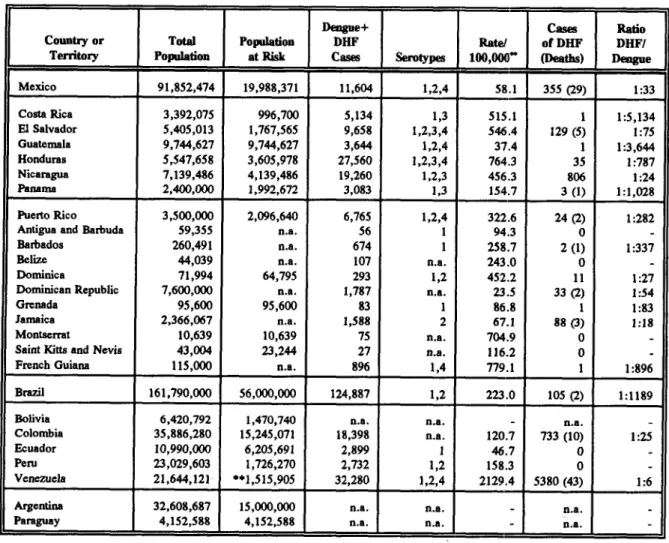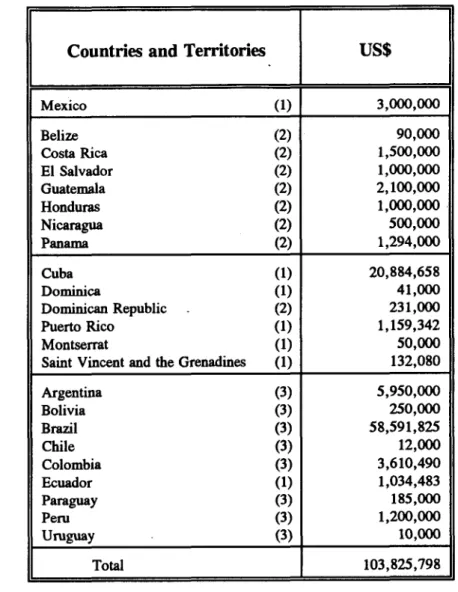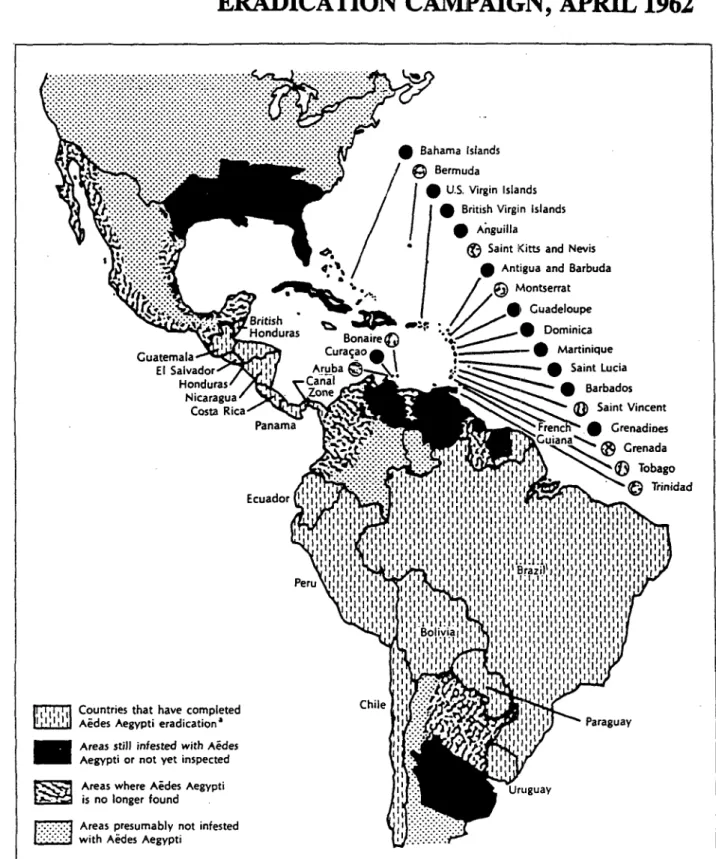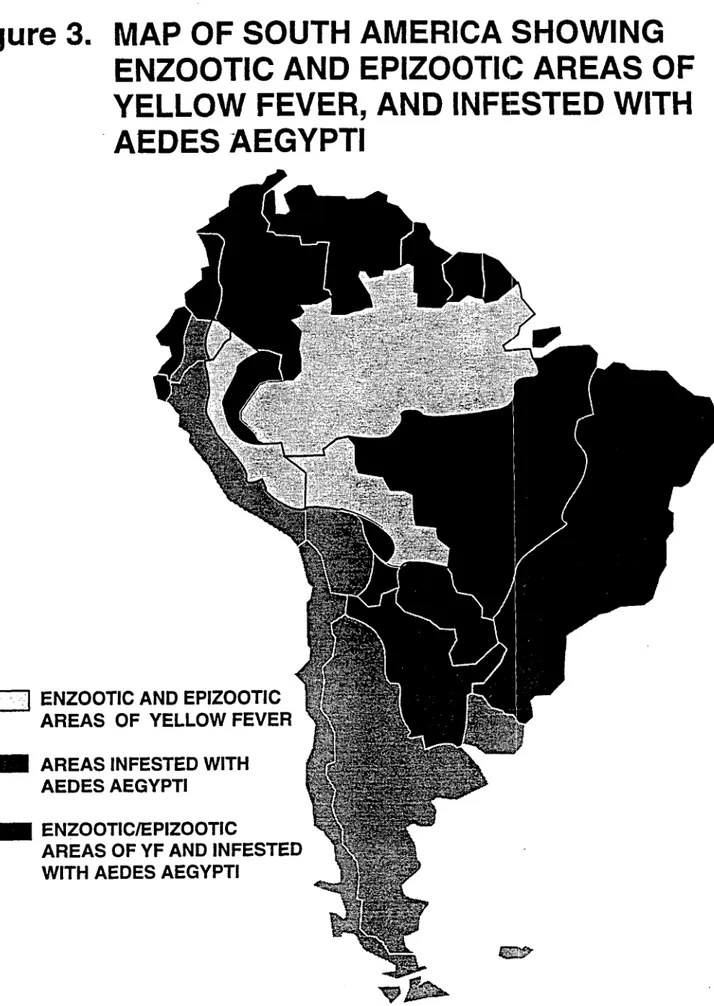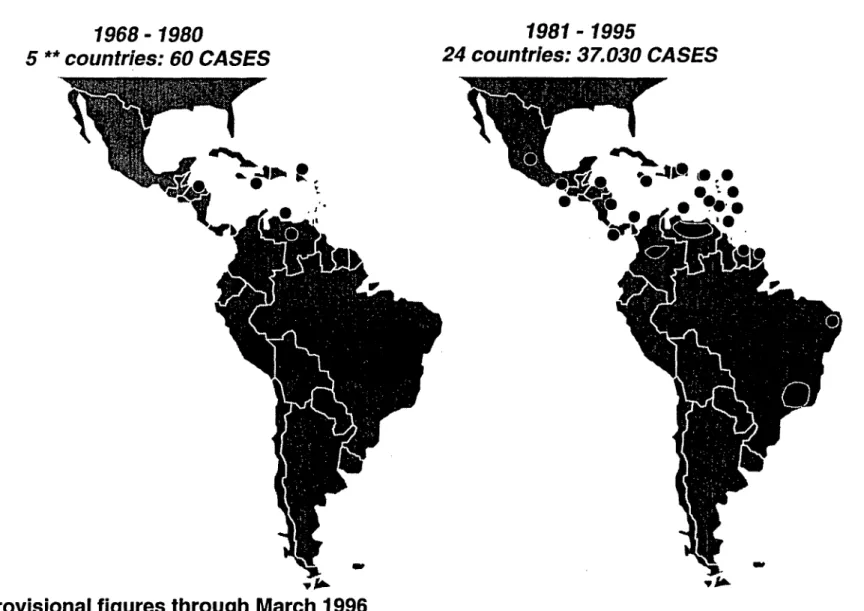regional committee
p )A PAN AMERICAN WORLD
HEALTH HEALTH
ORGANIZATION ORGANIZATION
XXXIX Meeting XLVIII Meeting
Washington, D.C. September 1996
Provisional Agenda Item 5.6 CD39/16 (Eng.)
18 July 1996
ORIGINAL: ENGLISH
AEDES AEGYPTI
The 118th Meeting of the Executive Committee reviewed the attached report which describes a study on the feasibility of eradicating Aedes aegypnt. This study was carried out by a task force established by the Pan American Health Organization for the purpose of issuing a recommendation on whether it was timely, appropriate, and feasible to draw up a plan for the eradication of Aedes aegypti from the Americas. The Task Force unanimously believed that it was timely and appropriate to consider drawing up a hemispheric plan to eradicate Aedes aegypti. It identified key challenges that would
have to be overcome in order for the plan to be successful. With these in mind, the majority of the 12 members (eight) believed that it was feasible to draw up a plan, as these challenges could be met now or in the near future. Four members dissented.
The presentation of the topic to the Executive Committee complemented the written document. It described the factors which contribute to the increase in the Aedes aegypti population, the diseases transmitted by this mosquito and their epidemiology, and
the present situation in the Americas.
Dengue and dengue hemorrhagic fever (DHF) have increased tremendously in the Region over the past several years. All four serotypes of the virus are now circulating in the Region, thus increasing the risk of DHF. PAHO has supported countries in numerous activities in response to this disease threat. A regional network of 49 dengue laboratories with a quality control program has been established; training for clinical case diagnosis and case management has been carried out in Central American countries; evaluation of measures to be used in epidemics was carried out in five countries; and 14 countries received technical cooperation to improve program performance. A guide for the prevention and control of dengue and DHF has been produced and distributed widely throughout the Region.
CD39/16 (Eng.) Page 2
The Executive Committee discussed at length the material in the document as well as the presentation on the topic. The Committee recognized the increasing danger posed by dengue and was convinced of the need to intensify efforts to combat Aedes aegypti.
While acknowledging the difficulty that the Task Force had in deciding between eradication or control at this time, the Committee believed that a common understanding of the situation and strategy for addressing Aedes aegypti was important. It therefore supported the development of a hemispheric plan to combat the vector. It particularly noted the need to have a broad-based public health approach in this endeavor. Specifically, the Committee identified a combination of methods, including environmental sanitation and public education as well as integrated vector control, as important features of a hemispheric plan.
The Committee's debate and eventual consensus are reflected in the resolution it adopted, which is presented for consideration by the Directing Council and is transcribed below:
THE 118th MEETING OF THE EXECUTIVE COMMITTEE,
Having seen the document "Study on the Feasibility of Eradicating Aedes aegypti"
(Document CE118/16),
RESOLVES:
To recommend that the XXXIX Meeting of the Directing Council adopt a resolution in the following terms:
THE XXXIX MEETING OF THE DIRECTING COUNCIL,
Having seen the document "Study on the Feasibility of Eradicating Aedes aegypti"
(Document CD39/16);
Considering the increasing incidence of dengue and dengue hemorrhagic fever in the Region of the Americas and the potential danger of a re-emergence of urban yellow fever;
Recognizing the importance of these diseases for public health in the Region and their impact on the economies of the Hemisphere; and
CD39/16 (Eng.) Page 3
RESOLVES:
1. To urge Member Governments:
(a) To collaborate in the development of a hemispheric plan that supports from a public health and environmental perspective (in particular the areas of water and
garbage) the combating of Aedes aegypti as a public health problem;
(b) To use mass communication to inform and educate the population and strengthen community participation in integrated vector combat activities;
(c) To promote epidemiological, entomological, and environmental surveillance and strengthen national laboratories to enable them to participate effectively.
2. To request the Director, as resources permit:
(a) To review, in cooperation with relevant Member Governments, current programs to determine the effectiveness of different approaches, from a public health perspective, in combating Aedes aegypti as a public health problem;
(b) To support the improvement of national and regional surveillance, and to facilitate the implementation of integrated combat measures;
(c) To cooperate in the preparation and implementation of national plans to combat
Aedes aegypti.
(d) To build consensus and cooperation among countries to address the threats of dengue and yellow fever.
CD39/16 (Eng.) Annex
-2-CONTENTS
Page
Executive Summary ... 3
1. Introduction ...-. 4
2. Historical Background ... 4....4
3. Present Situation ... 6
3.1 Epidemiological Status ... 6
3.2 Prevention and Control Activities ... 6
3.3 Current Aedes aegypti Programs ... 6
4. Recommendations of the Task Force ... 8
Tables ... 11
Figures ... 14
-3-EXECUTIVE SUMMARY
With the deterioration of the dengue situation and the notable increase in dengue hemorrhagic fever (DHF) in the Region, PAHO convened a group of experts in 1991 in order to develop guidelines for the establishment of effective programs to control dengue and DHF. These guidelines were widely disseminated and are being applied in several countries of the Americas. As the situation continued to deteriorate, in September 1995 the PAHO Directing Council asked the Director "to establish immediately a technical task force to study the feasibility, timeliness, and appropriateness of drawing up a hemispheric plan for the eradication of Aedes aegypti as an effective means of controlling dengue and urban yellow fever in the Americas. " A task force was established and, after preparation of background material by the Secretariat, the Task Force met at the Fundagco Oswaldo Cruz, in Rio de Janeiro, Brazil, on 16-18 April 1996.
The Task Force recognized and congratulated the Government of Brazil for the bold initiative it had taken to propose eradication of A. aegypti in that country in order to eliminate dengue and DHF.
4
-1. Introduction
In recent years considerable attention has been given to the serious threat posed by new, emerging, and re-emerging infectious diseases. The magnitude of the problem is illustrated by the appearance of several new pathogens which cause disease of marked severity, as well as old pathogens that have re-emerged and are having a considerable impact in the Americas. One of those is dengue virus, which is widely dispersed and has become an important problem in the Western Hemisphere.
The fundamental framework for species eradication in the Americas emerged in 1947, when the I Meeting of the Directing Council of the Pan American Sanitary Organization (an earlier name for PAHO) adopted a resolution that established a policy to eradicate Aedes aegypti in the Region and requested that the Pan American Sanitary
Bureau (PASB) develop an eradication program under its auspices. After notable successes in the 1950s and 1960s, the program went into decline and now all countries, with the exception of Bermuda, Canada, Chile, and Uruguay, are infested. Since the early 1980s there has been a notable increase of dengue and dengue hemorrhagic fever (DHF) in the Region. Because the mosquito vector is the same, there is the additional potential threat of urban transmission of yellow fever.
2. Historical Background
The issue of the eradication of A. aegypti in the Americas had been debated since at least the 1920s. In 1934 approval was given in Brazil, albeit unofficially, to a proposal for the eradication of A. aegypti. In 1942 the Government of Brazil officially approved the eradication of A. aegypti. The I Meeting of the Directing Council of the Pan American Sanitary Organization, held in Buenos Aires in October 1947, analyzed a joint report of Argentina, Bolivia, Brazil, and Paraguay on the plan for hemispheric eradication of A. aegypti proposed by Brazil. The Directing Council endorsed the
proposal and resolved to entrust to PASB the solution of the hemispheric problem through the development of a program under its auspices. Hemispheric eradication thereby became official policy.
The hemispheric campaign was organized by PASB, and its success was reflected in the fact that, by 1962, 18 continental countries and several Caribbean island countries had achieved eradication (Figure 1).
The reasons for the success of the eradication efforts were:
Adequate national and external funding for well-trained personnel, equipment, and insecticides;
5
-Total coverage of infested areas in time-limited programs;
Use of DDT for perifocal spraying in and around all breeding sites;
Streamlined, semiautonomous programs, separate from national health programs;
Centralized, vertically structured programs with a military-type organization and clear lines of command, strict supervision, and a high level of discipline. Community participation occurred, but was limited and not systematic.
Unfortunately, after 1962 only three additional countries or territories eliminated the vector. Even more serious, however, was that the countries which had achieved eradication were becoming reinfested in the 1960s. Not all countries in the Hemisphere had been willing to eradicate A. aegypti. Countries that were still infested (Cuba, United States of America, Venezuela, and several Caribbean countries) became sources of reinfestation for those that had eradicated the vector.
From 1947-1985, the Directing Council passed numerous resolutions concerning the eradication of A. aegypti.
Over time, in most of the countries that achieved eradication, the programs against A. aegypti lost political importance, and surveillance for reinfestation gradually declined so that small reinfestations could no longer be detected. In addition, once a reinfestation was discovered, because of the centralized structure of the program the response usually came too late, and the resources to eliminate it before it could spread tended to be insufficient, although control was still possible (Figure 2). In 1985 the XXXI Meeting of the Directing Council adopted a resolution on control or eradication of A. aegypti, which is interpreted as the end of the policy for species eradication in the Region.
-6-3. Present Situation
3.1 Epidemiological Status
Tables I and 2 show the countries infested with A. aegypti, the size of the infested area, the population at risk, and the incidence of dengue and DHF.
The severe outbreak of jungle yellow fever (YF) that affected Peru in 1995 near urban centers infested with A. aegypti illustrates that the urbanization of the disease is a real threat. The risk is potentially greater due to the presence of Aedes albopictus in Brazil, Dominican Republic, El Salvador, Guatemala, Mexico, and the United States of America. This is an exotic species which invaded the Americas in the mid 1980s. Laboratory studies show that A. albopictus can transmit yellow fever virus. As this species can breed in domestic and in forest environment, it could potentially serve as a bridge between the jungle and urban cycles of yellow fever. There is a real possibility that A. albopictus will infest enzootic areas of yellow fever in the near future, thus increasing the risk of urbanization of YF. Although an effective vaccine against YF is available, its coverage is low in most enzootic areas and virtually absent in non-enzootic areas infested by A. aegypti and by A. albopictus.
3.2 Prevention and Control Activities
A program to control dengue and A. aegypti should be integrated in its implementation and include the following components: epidemiological surveillance; education of the medical community; entomological surveillance; and integrated vector control, which is the logical combination of all the available methods of control in the most effective, economic, and safe manner, in order to limit the A. aegypti population to acceptable levels. Vector control methods include environmental management, chemical control, and biological control. A control program such as this, in order to be successful, needs to be sustained indefinitely.
3.3 Current Aedes aegypti Programs
-7-The data presented below are from the 28 countries that responded. Questionnaires from Belize, Brazil, Guatemala, and Haiti have not been received. The answers on the questionnaires were not always the same as official government reports, but are presented here without modification.
3.3.1 Entomological Aspects
With the exceptions of Bermuda, Canada, Chile, and Uruguay, all the countries of the Americas are reinfested with A. aegypti. This mosquito has been found in natural breeding sites (tree holes, leaf axils) in 19 countries, and has been found up to 500 meters away from human habitation and up to 1800 meters above sea level. In eight countries there is infestation in areas where there is no access via roads or waterways. In 12 countries there is infestation where access is difficult or dangerous because of social problems (e.g., armed conflict, slums). Refusal of entry of health workers into houses is low in most countries (0% - 3%), but in some areas it is as high as 30% (Ecuador).
Aedes albopictus is now found in Brazil, Dominican Republic, El Salvador, Guatemala, Mexico, and United States of America. In 19 countries there is a surveillance system for A. albopictus, and in 16 countries container larvae are identified with a bacteriological microscope.
3.3.2 Epidemiological Aspects
During the past five years there has been an increase in the total number of dengue and DHF cases and deaths. In 1995, a total of 274,422 dengue cases, 7,715 DHF cases, and 104 deaths were reported. A total of 522 sylvatic yellow fever cases were reported from Bolivia (15 cases), Brazil (4), Colombia (3), Ecuador (1), and Peru (499).
3.3.3 Economic Aspects
Per capita expenses for Aedes programs are highest in the Caribbean (average of US$ 2.03 per capita, maximum of $4.70), less in Central America and Mexico (average $0.57, maximum of $1.94), and lowest in South America (average $0.29, maximum of $0.65). Table 3 shows the spending by different countries in 1995.
3.3.4 Operational Aspects
-8-Resistance to several insecticides used in Aedes control (temephos, malathion, lambda-cyhalothrine) is appearing in the Caribbean area.
3.3.5 Legal Aspects
In 13 countries there is legislation for the establishment of an Aedes program. In 15 countries there are laws to permit the entrance of field personnel into houses. Eight countries levy fines on people or businesses that have potential or actual breeding sites on their premises. In four countries there are laws prohibiting the importation of used tires. Six countries require the treatment of used tires at the point of origen. Disinsectation of aircraft arriving from infested areas is done in 14 countries. Notification of dengue cases is obligatory in 21 countries.
3.3.6 Political Aspects
In 21 countries the fight against dengue is said to be a high priority in the national health policy. In 15 countries, eradication is reported to be compatible with the national health policies and plans. Twelve countries consider that an eradication program is feasible, timely, and appropriate for them. They think that the structure of such a program should be decentralized (15 countries), vertical (four countries), or "other" (two countries). Only two countries (Argentina and Trinidad and Tobago) said that they foresaw the conversion of their program to an eradication program, and only one country (Cuba) said that it had sufficient resources for eradication. Possible types of external financing mentioned were donations (seven countries) and a combination of donations and loans (eight countries).
In recent meetings, certain countries have made declarations concerning their future programs. In the Central American Seminar-Workshop on Strategies for the Prevention and Control of Dengue and Dengue Hemorrhagic Fever in Guatemala (May 1995), the seven countries of Central America chose the strategy of control over the strategy of eradication. In the meeting of the Southern Cone countries in Paraguay in April 1996, the representatives of Argentina, Bolivia, and Paraguay stated that their countries would embark on eradication programs, and the representatives of Peru said that their country would continue with its control program.
4. Recommendations of the Task Force
-9-The members of the Task Force agreed that the following key challenges needed to be considered in order to determine the feasibility of drafting a hemispheric plan for the eradication of A. aegypti:
(a) Magnitude of the problem: The geographical extension of the infested areas, the size of the urban population affected, the penetration of infestation into rural areas, and the numbers of containers per premises are all greater than during the first eradication campaigns of the 1950s and 1960s. The magnitude of the problem must be clearly defined.
(b) Eradication strategy: Eradication requires universal coverage of every
municipality, every building and dwelling, and every container in the infested areas. The original eradication campaigns that succeeded in eliminating A. aegypti from 21 countries were vertically structured and rigorously supervised. Most of the countries in the Americas consider that future eradication programs should be decentralized. However,
A. aegypti has never been eradicated from any country with a decentralized program. The efficacy of any new eradication strategy needs to be demonstrated in pilot projects.
(c) Cost: The cost of future eradication efforts will probably be much greater than previous campaigns and much greater than present control programs. Realistic estimates of costs required to achieve the goal and identification of national and international sources of funds are needed. It should be noted that programs which have large environmental sanitation components will bring health and quality of life benefits in addition to eradication or control of A. aegypti.
(d) Political will: As governments and government officials change, health priorities change. In order for eradication to be maintained, subsequent surveillance against reinfestation must continue uninterrupted indefinitely.
(e) International coordination: For hemispheric eradication to be completed, all of the countries of the Americas, as well as European authorities responsible for territories in the Americas, must agree to eradicate. Not all of the countries eradicated A. aegypti
during the early campaigns, and many of these same countries may not decide to launch an eradication program in the future. Also, A. aegypti is present in great numbers in Asia, posing the risk of reinfestation from that region.
-10-The Task Force also recommended that PAHO review the list of key challenges
and provide an update and report on their status to Member States.
11
-Table 1: Aedes aegypti Infestation in the Americas, 1995
KmI Population Number of Houses Country or Infested Infested Infested
Territory Country Area' Countr Area' Country Area
Central and North America
Costa Rica 50,900 40,720 3,392,075 996,700 678,415 28,156 El Salvador 21,041 782 5,405,013 1,767,565 1,236,188 333,503 Honduras 112,492 67,495 5,547,658 3,605,978 906,698 **90,670 Mexico 1,967,183 320,560 91,852,474 19,988,371 18,297,306 3,188,856 Nicaragua 121,428 98 4,139,486 - 722,280
Panama 75,517 33,084 2,400,000 1,922,673 597,058 452,880 United States 2,000,021 - 76,467,421
Caribbean
Bermuda 21 - 60,000 26,000
Cuba 110,992 4,237 11,000,000 419,887 3,302,557 352,373 Dominica 771 - 71,994 64,795 20,000 3,600 Dominican Republic 48,000 - - 2,096,640 5,600 181 Grenada 344 344 95,600 - 35,554 -Montserrat 104 69 10,639 - 6,300 6,300 Nevis 93 - 9,004 10,639 2,891 278 Puerto Rico 8,960 5,376 3,500,000 - 700,000
Saint Kitts 176 3 34,000 - 33,500 Saint Vincent and
the Grenadines 388 388 110,000 12,605 271,871 Trinidad and Tobago 5,128 - 1,234,388 - -South America
Argentina 2,780,40 35,000 32,608,687 15,000,000 10,096,875
Brazil 8,511,965 865,000 161,790,000 56,000,000 32,200,000 11,200,000 Bolivia 1,098,581 358,987 6,420,792 1,470,740 1,701,142 **1,660 Colombia 1,141,748 689,339 35,886,280 15,245,071
Ecuador 272,045 18,150 10,990,000 6,205,691 715,802 Paraguay 406,752 406,752 4,152,588 4,152,588 855,547
Peru 1,285,216 273,081 23,029,603 1,726,270 4,605,920 345,254 Venezuela 912,050 911,930 21,644,121 1,515,905 4,328,824 303,181
* Estimated
-
12-Table 2: Population at Risk and Incidence of Dengue and Dengue Hemorrhagic Fever (DHF) in the Americas, 1995
Dengue+ Cases Ratio Country or Total Population DHF Rate/ of DHF DHF/
Territory Population at Risk Cases erotys 100,00 (Deaths) Dengue Mexico 91,852,474 19,988,371 11,604 1,2,4 58.1 355 (29) 1:33 Costa Rica 3,392,075 996,700 5,134 1,3 515.1 1:5,134 El Salvador 5,405,013 1,767,565 9,658 1,2,3,4 546.4 129 (5) 1:75 Guatemala 9,744,627 9,744,627 3,644 1,2,4 37.4 1 1:3,644 Honduras 5,547,658 3,605,978 27,560 1,2,3,4 764.3 35 1:787 Nicaragua 7,139,486 4,139,486 19,260 1,2,3 456.3 806 1:24 Panama 2,400,000 1,992,672 3,083 1,3 154.7 3 (1) 1:1,028 Puerto Rico 3,500,000 2,096,640 6,765 1,2,4 322.6 24 (2) 1:282 Antigua and Barbuda 59,355 n.a. 56 1 94.3 0 -Barbados 260,491 n.a. 674 1 258.7 2 (1) 1:337 Belize 44,039 n.a. 107 n.a. 243.0 0 -Dominica 71,994 64,795 293 1,2 452.2 11 1:27 Dominican Republic 7,600,000 n.a. 1,787 n.a. 23.5 33 (2) 1:54 Grenada 95,600 95,600 83 1 86.8 1 1:83 Jamaica 2,366,067 n.a. 1,588 2 67.1 88 (3) 1:18 Montserrat 10,639 10,639 75 n.a. 704.9 0
-Saint Kitts and Nevis 43,004 23,244 27 n.a. 116.2 0
-French Guiana 115,000 n.a. 896 1,4 779.1 1 1:896 Brazil 161,790,000 56,000,000 124,887 1,2 223.0 105 (2) 1:1189 Bolivia 6,420,792 1,470,740 n.a. n.a. - n.a.
-Colombia 35,886,280 15,245,071 18,398 n.a. 120.7 733 (10) 1:25 Ecuador 10,990,000 6,205,691 2,899 1 46.7 0
-Peru 23,029,603 1,726,270 2,732 1,2 158.3 0
-Venezuela 21,644,121 **1,515,905 32,280 1,2,4 2129.4 5380 (43) 1:6 Argentina 32,608,687 15,000,000 n.a. n.a. n.a.
-Paraguay 4,152,588 4,152,588 n.a. n.a. - n.a.
* Rates estimated over population at risk when information is available Subject to confirmation
n.a.: Not available
13
-Table 3: Spending on Dengue Control Activities in the Countries of the Americas, 1995
Countries and Territories US$
Mexico (1) 3,000,000
Belize (2) 90,000
Costa Rica (2) 1,500,000
El Salvador (2) 1,000,000
Guatemala (2) 2,100,000
Honduras (2) 1,000,000
Nicaragua (2) 500,000
Panama (2) 1,294,000
Cuba (1) 20,884,658
Dominica (1) 41,000
Dominican Republic (2) 231,000 Puerto Rico (1) 1,159,342
Montserrat (1) 50,000
Saint Vincent and the Grenadines (1) 132,080
Argentina (3) 5,950,000
Bolivia (3) 250,000
Brazil (3) 58,591,825
Chile (3) 12,000
Colombia (3) 3,610,490
Ecuador (1) 1,034,483
Paraguay (3) 185,000
Peru (3) 1,200,000
Uruguay (3) 10,000
Total 103,825,798
Data obtained from survey done by PAHO Up to 30 August 1995
Data obtained from Doc. OPS/HPC/HCT/96.066 (1)
14
-Figure 1.
STATUS OF THE AEDES AEGYPTI
ERADICATION CAMBPAIGN, APRIL 1962
I
' Bermuda
| · U.S. 'Virgin Islands
/* British Virgin Is | ^ * Anguilla
©* Saint Kitts
%
Guatemala
El Salvador I'
Honduras Nicaragua
Costa Rica
Panam
I IliII Countries that have completed
IL'1 !, A&des Aegypti eradication' Areas still infested with Aides
Aegypti or not yet inspected
Jk., Areas where Aides Aegypti is no longer found
Areas presumably not infested with Aedes Aegypti
q as \ / | Antigua and Barbuda
4 .|
//
*,I
Guadeloupe
as BonareG Dominica
Curajao. ' -* Martinique
aruba rua Saint Lucia
anaZo.ne. J Barbados
>,
_ )Saint Vincentla =,tgcuj-_ \R reno * Grenadines
: X.~.~!.l:'::..::::.. '...:G__..ri.. ~N,~k~uia~ .,tGrenada ~.~ii!!!!: "~ 4Tobago
' I ' '~ (i Trinidad Ii II
I 1 1111 111111111 I 11I Br 111 I i
A llllll ll
I I* ' '-:,Y
-I; ~ ' I I , Paraguay
t
Uruguay
aEradication carried out according to the standards established by the Pan American Health Organization lands
s and Nevis
Figure
2.
1930
4,
DISTRIBUTION OF AEDES AEGYPTI
IN THE AMERICAS
1962
1995
0~6.u4w 6I
L t~~~~~~
*. & m . .
I
!-i,
rSI~~o
-
16-Figure 3. MAP OF SOUTH AMERICA SHOWING
ENZOOTIC AND EPIZOOTIC AREAS OF
YELLOW FEVER, AND INFESTED WITH
AEDES AEGYPTI
I
'
:'
ENZOOTIC AND
EPIZOOTIC
AREAS OF YELLOW FEVER
AREAS INFESTED WITH
AEDES AEGYPTI
ENZOOTIC/EPIZOOTIC
AREAS OF YF AND INFESTED
WITH AEDES AEGYPTI
L
Figure 4. DENGUE HEMORRHAGIC FEVER IN THE AMERICAS 1995*
1968- 1980
5 ** countries: 60 CASES
0411hp
`5
1981 - 1995
24 countries: 37.030 CASES
P,
et
r~-. e ~-i~', 0go * .
V;m*
0.0
A01=12
iI I..
,V
*
Provisional figures through March 1996
** Four of these countries also reported DHF cases during 1981-95
,V
1 I
